Hip Drop Running Form
![]()
You may recognise the presence of a hip drop in your own running gait. Perhaps you’ve run behind a fellow athlete who’s hips seem like they would be more at home on the catwalk!
In the video above I discuss this common running technique trait, often referred to as a Trendelenburg Gait.
Hip Drop Running Form: Poor Lateral Stability
It was in one of the first articles on this website that I wrote about the importance of training all three planes of motion for us runners, despite the fact that running itself (at first glance at least) looks like a very linear movement pattern.
While running forward in a straight line looks to be a linear action, dig deeper and you can observe what’s happening joint-by-joint with every stride, you’ll see that loading occurs in the forward-and-back (sagittal) plane, side-to-side (frontal) plane and rotational (transverse) plane.
When it comes to the hips. We know that the majority of the movement during running gait happens in the forward-and-back plane. You can no doubt visualise the knee driving forwards, while the opposite leg driving backwards as we propel ourselves forwards. This can only happen efficiently if the hips are stable and controlled in the other planes of motion.
When the foot is on the ground, supporting us on one leg through mid-stance of running gait, Glute Medius has to work hard to create lateral stability around the hip. This enables us to effectively maintain a level pelvis in the frontal plane.
If there’s a problem with this process, and Glute Med is weak or inhibited, then commonly we’ll see the hip drop running trait that is sometimes linked to injuries such as ITB Syndrome and Low Back Pain.
Todd Kenyon does a great job of describing this hip drop, amongst other running technique observations in this video of the Elite Women’s field at Boston Marathon a few years ago:
Boston Marathon 2013 Pro Women Run Form – TTBikeFit
We’ve written before here about “Trendelenburg Gait” and how this lack of hip stability can often be part of the bigger picture when it comes to running injury.
Of course, it’s never as simple as saying that runners who move like this will end-up suffering with X, Y, or Z injury… training errors play just as bigger part in causing injury as biomechanics!
However, at very least, a lack of hip stability and subsequent hip drop is likely to negatively affect the efficiency of a runner.

Correcting a Hip Drop in Your Running Gait
If you’ve noticed that you have a tendency to drop one hip when you run, leading to a lateral shift of the pelvis, there are a number of exercises and running cues you can work on to improve your running form.
Having said that this isn’t specifically predictive of injury, if you do happen to suffer with ITB Syndrome, Patellofemoral Pain, Shin Splints, Piriformis Syndrome, Low Back Pain… (you get the point) I wouldn’t ignore the hip drop, as there are some simple things you can do to improve lateral hip stability:
Exercises to Correct Your Hip Drop
Here’s a simple routine you can follow 3-5 times weekly for 6 weeks to help improve lateral control of the hip, and reduce hip drop when you run:
- Hip Hitches – 3 sets of 15 each side
- Isometric Glute Med Hold – 3 sets of 30 second holds each side
- Resistance Band Crab Walk – 3 sets of 30 seconds each direction
- Glute Med & Psoas Drill – 3 sets of 10 each side
I hope this helps. Do let me know in the comments below if you have any questions…
The post Hip Drop Running Gait: Causes & Fixes appeared first on Run Coaching, Ironman and Triathlon Specialists - Kinetic Revolution.
from Run Coaching, Ironman and Triathlon Specialists – Kinetic Revolution http://www.kinetic-revolution.com/hip-drop-running-gait-causes-fixes/

No comments:
Post a Comment